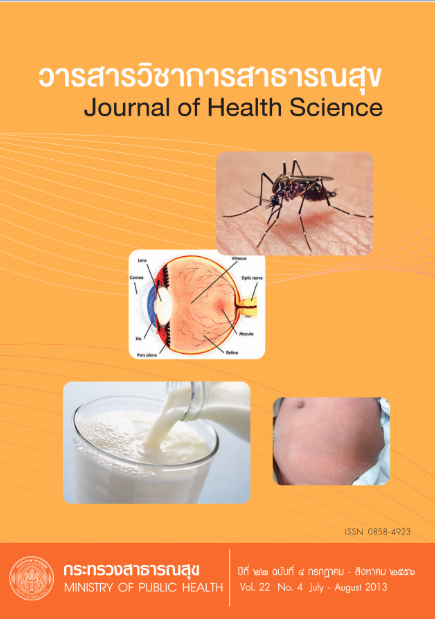Evaluation of District Surveillance and Rapid Response Team, Primary Public Health Response Level, 2011
Keywords:
evaluation, standard Surveillance and Rapid Response TeamAbstract
This descriptive study was aimed at evaluating the district Surveillance and Rapid Response Teams (SRRT), primary public health response level in 14 in setups in four provinces-Saraburi, Lop Buri, Chai Nat and Ang Thong as recommended by a SRRT standard, Bureau of Epidemiology, Department of Disease Control. Its benchmark for district SRRT was divided into three levels: basic, good and excellent. In data collection, documentation review and interview of core members of SRRT were used. It was found that 13 SRRTs passed the primary standard. The only failing was a one lack of investigation reports of outbreaks. None reached the good level.
Based on 16 indicators, 96.15 percent of the district SRRTs were at the basic level. Yet only 36.26 percent of them reached the good level of which indicator 12 on timely alert and outbreak report showed the maximum compliance among 69.29 percent. On that good level, all failed on outbreak or unusual health threat investigation as shown by indicator 8. Ang Thong maintained that level in 57.69 percent of their teams whereas Chai Nat showed its achievement in 38.50 percent, Lop Buri 32.69 percent and Saraburi 30.77 percent.
Based on the main groups of the indicators less than 42.86 percent of the teams were classified in the good level. Where all Ang Thong teams showed complete preparedness, 16.67 percent showed operating capability, while Lop Buri got 62.50 percent but team work standard got only 8.33 percent. Saraburi and Chai Nat were classified each standard below 50 percent.
All the district SRRTs were at the basic level and failed to reach the good level. As such, they become the weak link in the disease prevention and control. Capacity building of the district SRRTs is needed in terms of operating capability, related to team building, their leaders should be accommodating and focusing on team morale. Once the investigation is carried out, a preliminary report is required and its final report to be always duly submitted to the executive.
Downloads
Downloads
Published
How to Cite
Issue
Section
License
Copyright (c) 2017 Journal of Health Science- วารสารวิชาการสาธารณสุข

This work is licensed under a Creative Commons Attribution-NonCommercial-NoDerivatives 4.0 International License.







